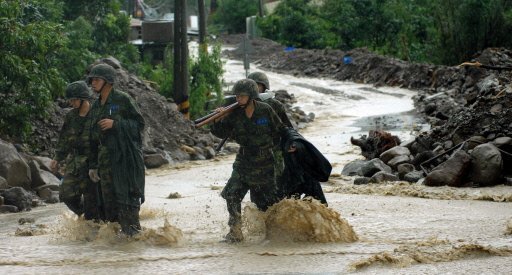Typhoons kill 28 in East Asia
TAIPEI: At least 31 people were known to have died and scores more were reported missing Monday after typhoons battered East Asia, as parts of the region experienced their worst weather in half a century.
Almost half of those killed were in Taiwan when Typhoon Morakot slammed into the island, dumping a record 2.5 metres (100 inches) of rain at the weekend.
The storm hit mainland China on Sunday afternoon, where it claimed at least three lives as authorities ordered more than a million people to evacuate several provinces.
In Japan, 13 people died in floods and landslides caused by torrential rain as Typhoon Etau bore down on the archipelago, forcing thousands into emergency shelters and disrupting travel networks.
Rescuers in Taiwan were battling to reach hundreds cut off by Morakot as widespread floods and mudslides knocked out railway and road traffic, cut power and water supplies and brought down bridges.
In the southeast, a six-storey hotel collapsed into a river. Staff and guests had already been evacuated, television reports said.
At least 15 people were confirmed dead on the island and 55 others were still unaccounted for, rescue services said.
Officials estimated the storm had caused agricultural damage worth at least 3.4 billion Taiwan dollars (at least 100 million US).
In the southern county of Pingtung thousands of people were trapped in three coastal townships while in Kaohsiung county a bridge collapsed, cutting off road access to a remote village of 1,300 residents.
Local television reported that 200 homes in the village, Hsiaolin, were believed to have been buried in a mudslide.
Specially trained rescuers and soldiers from an elite unit were helicoptered into the village, where survivors spoke of family members being engulfed by mud.
A 46-year-old man, identified only by his surname Weng, told the TVBS cable news network that he had narrowly escaped as he checked a makeshift wooden house near his home, but that 10 other family members disappeared in the mud.
"All of them were gone," he said in tears.
Tens of thousands of other people were also stranded in the counties of Tainan and Chiayi.
"This is the worst flooding in Chiayi in 50 years," county magistrate Chen Ming-wen said, referring to a typhoon that struck in August 1959, killing 667 people and leaving 1,000 missing.
In Japan's Hyogo prefecture more than 100 troops were deployed as a rain-swollen river burst its banks and inundated about 480 houses.
Brown waters engulfed the town of Sayo, ripping through the walls of buildings, toppling trees and flushing cars and furniture through the streets, television images showed.
"It was so scary, the water came surging with a roar," a male resident told public broadcaster NHK from the disaster-hit town. "I've lived here for 60 or 70 years, but I've never seen a scene like this before."
Typhoon Etau, packing winds of up to 108 kilometres (67 miles) an hour, was forecast to hit the Tokyo area Tuesday, Japan's meteorological agency said, issuing nationwide heavy rain and landslide warnings.
Twelve of the country's dead and several missing were reported in Hyogo, said a police spokesman. "We are now concentrating on rescue operations while trying to check if more people are missing," he told AFP.
Eight people were unaccounted for nationally, according to media reports.
In Okayama prefecture, a 68-year-old woman died and three others were injured as a landslide flattened two houses.
Typhoon Morakot made landfall on the Chinese mainland on Sunday afternoon, lashing cities in the area with 83 kilometre (51 mile) an hour winds, Shanghai's weather bureau said.
By Monday afternoon Morakot had killed at least three people on the Chinese mainland, officials said.
The three deaths occurred in Fujiang, Zhejiang, and Jiangxi provinces respectively. Another person in Fujiang province is missing, the Ministry of Civil Affairs said.
More than 7.8 million people in Fujian, Zhejiang, Jiangxi and Anhui provinces were affected by Morakot, forcing authorities to relocate 1.4 million, state news agency Xinhua reported.
Morakot was downgraded to a tropical storm by early afternoon but meteorologists warned it was still likely to bring rain of up to 90 millimetres (3.5 inches) an hour to Shanghai, China's largest city.






